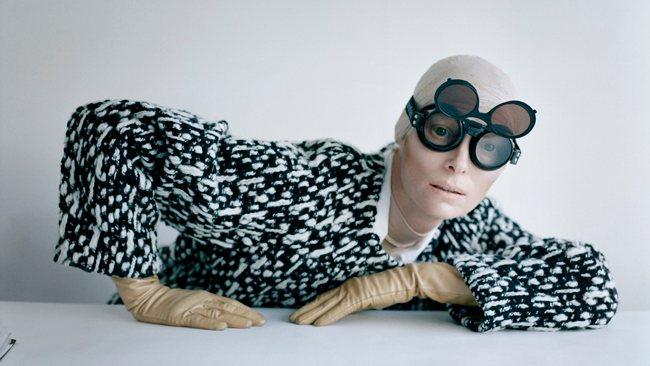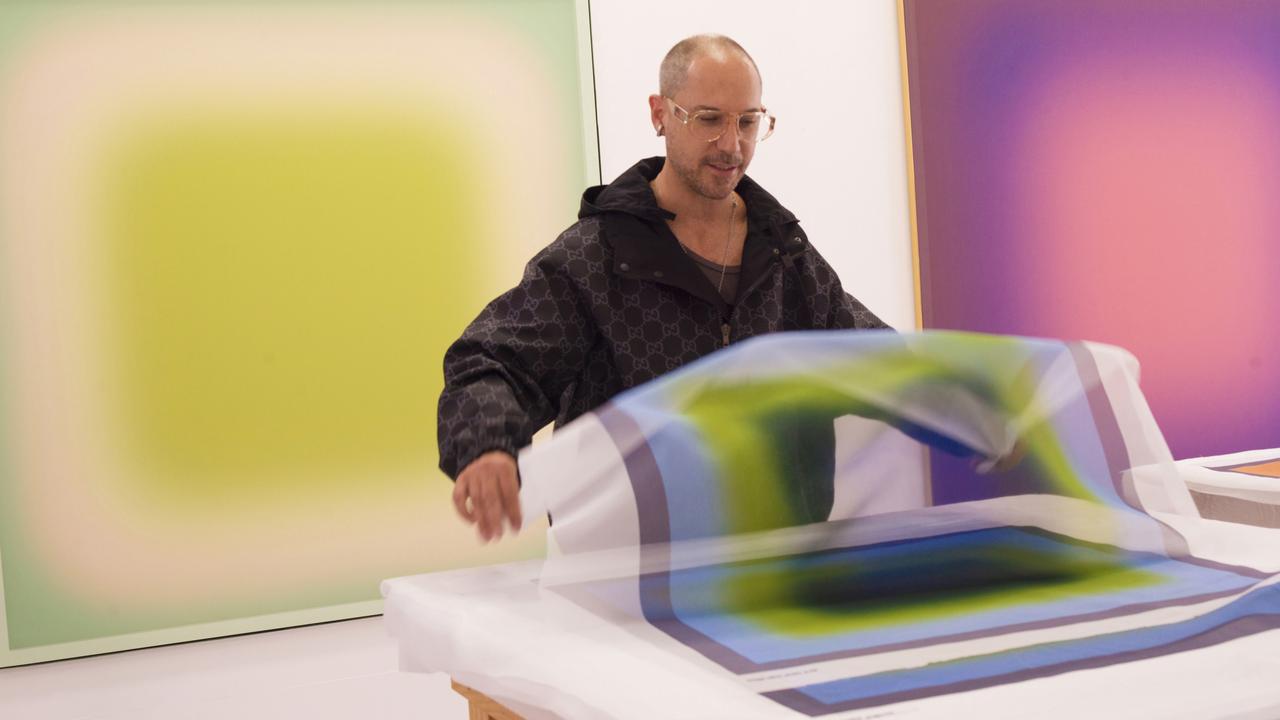Daydream believers
ESCAPE to an enchanted world, where Tim Walker's overflowing imagination supplies the fantasy - and big business buys in.

BRITISH photographer and filmmaker Tim Walker's fantastical fashion work is part of what he calls "the dream factory of photography".
His fashion shoots, for the likes of Vogue, Vanity Fair and W magazine and brands such as Mulberry and Hermes, are ones where the imagined worlds of Wonderland and Oz, the nostalgic freedom for the countryside in adventures like Swallows and Amazons and the silly impossibilities of children's nursery rhymes and fairytales such as Humpty Dumpty and The Nutcracker collide in vibrant Technicolor, bringing spectacular tales of giant dolls and 2m-tall candy canes, blue horses and flying tea cups, marionettes and baguette biplanes remarkably to life.
So it's a shame to discover, when news spread earlier in the year of a new exhibition and publication of an accompanying book of Walker's work, appropriately titled Story Teller, which will open this month at Somerset House in London, that this extraordinary but notoriously shy photographer doesn't "do" interviews.
Oh, but for the brief chance to delve into Walker's world, if just for an afternoon with a nice cup of tea and a piece of Battenberg cake (apparently one of his favourites), in an attempt to dig deep and decipher the way he captures such fabulous filmic flights of fancy. If one ever had a wish list of people to interview, Walker would always be one of them but, alas, this time around it was not to be. "Tim is a very private person," blinked back the email from his inhouse PR. "He goes by the philosophy that his work should speak for itself."
Now, from almost any other photographer such attitude would seem intolerably like a load of old egotistical codswallop and yet the more one probed those who have commissioned or collaborated with him since his very first shoots for British Vogue in 1995, the clearer it became that such reluctance to analyse his work is exactly what lends it such mesmerising, mysterious magic. For Walker, it's not there to be nitpicked and criticised - instead, it's there to whisk us away on its own particular brand of magic carpet ride, ferrying us away from the drudgery of the everyday and allowing ourselves a moment to disappear and dream.
"Tim's extraordinary work takes us on a journey into his exotic imagination," says musician Kate Bush, with whom Walker collaborated on the artwork for her album Director's Cut, released last year. When she thinks of Walker, she imagines "Tim perched up in the crow's nest of a giant toy sail-boat, sailing a painted sea, hunting for ship-wrecked dreams".
It is this exact sense of childhood fantasy, where the parallel lives of a model dressed in couture can co-exist with a life-size slithering snail or a Spitfire plane crashing through the living room, that makes his photography tick.
"I am very childlike in my feelings about things and the way I look at the world," he once said, and it seems to still hold true. By his own admission, he is still a little boy, endlessly curious and playful, disappearing into the worlds of his imagination and trying to make them real.
These worlds that he conjures often start in the pages of the many sketchbooks he has been keeping for more than 30 years. As a child, "I was always making little sorts of sketches that fascinated me - the same as I do now," explains Walker, now 42, in Story Teller of the diaristic scrapbooks that overflow with found images, cuttings from magazines and newspapers, and illustrations from children's picture books. "They are windows into places that mostly don't exist. You step into them and live in that environment," he says. And even though his work may have become more polished since he first started, "I'm still touring my imagination, visiting places" that are all a marvellous melange of memories and made-up tales.
"Everything I do comes out of these books."
Walker first hit the scene in the mid 1990s following a photography degree at Exeter University and a couple of fortuitous apprenticeships: the first, at the age of 19, in the Conde Nast library in London where he helped establish its Cecil Beaton archives; and then, following his degree, as an assistant to one of the world's most famous fashion photographers, Richard Avedon, in New York.
It was his portraits that drew British Vogue's editor Alexandra Shulman, one of Walker's key proponents at the start of his career, to his work. "They felt very real - he was very good at capturing something interesting about the people he was photographing," she says. Italian Vogue's editor Franca Sozzani, another early fan, agrees.
The first picture of Walker's she saw was of a butterflycatcher - "nothing at all to do with fashion but this was the only picture I needed to see to understand and commission him". From this picture, she says, she knew exactly what was in his heart "because there was an honesty displayed there, an individual voice".
"Whether it is a portrait or a fashion shoot, there is a narrative to what he does," says Shulman. "It's not a sequence of abstract pictures; what is special to him is the wealth of ideas that he brings." She cites as example the shoots Walker has done for her in countries such as India and Mongolia, where he not only captured extraordinary images of the models and the clothes but of the location's people, culture and physical beauty. "I like the sense of place he captures in his photographs," she says. "I can send him somewhere extraordinary and he returns with these pictures that get everyone excited about where it is; and then he adds in his particular magic and fantasy, and it's totally unique."
Gallerist Michael Hoppen, who represents Walker globally, says it was not until he saw the look of complete enchantment on his children's faces at the London Design Museum's 2008 exhibition of Walker's work that he knew this was one photographer he wanted to know better. "His honesty, his love for life and his work are all very positive," says Hoppen. "He is not a classic fashion photographer, more like a great artist." Central, too, to the essence of storytelling that Hoppen so admires in Walker's photography is "the way he works with a longrunning 'family' of stylists and set designers who help to give his joyfully innocent vision its distinctive signature".
Talented creative director and set designer Simon Costin is one member of that all-important "family". With Walker, he has created everything from miniature glass greenhouses and giant, blood-red cherries, to an elaborate tea party scene under and within the boughs of a large oak tree (picture hanging beds, a chest-of-drawers and armchairs nestled within branches and a table fully laden for a feast underneath). He recently recreated Hokusai's Great Wave off Kanagawa in the living room of a grand English country house for a story, appropriately titled "Magical Thinking", for W magazine. "The rare thing with Tim's fashion work is the way he builds narratives that don't necessarily rely on the models or the clothes being depicted. A good model is, of course, always vital to the finished image if it is a fashion shoot but the narrative is really the thing leading the story," says Costin. Such combined imaginative force has led to some surreal situations. "Once when we set Humpty Dumpty up in a field of corn and the local farmer drove past, he couldn't quite believe what he was seeing as a model skipped about with a large butterfly net and Humpty sat with a bemused look on his face."
For the 2009 spring/summer issue of Le Monde d'Hermes magazine, Walker and another long-term collaborator Shona Heath created an entire issue under the guidance of the jovial charm of its editor-in-chief Stephane Wargnier. "The magazine is a way for the house to tell stories about Hermes and its way of life, and Tim's work coincides so perfectly with what we French refer to as fantasie - for us, this is the 18th-century spirit for pleasure, folly and the bizarre - and I have always felt that Tim is the inheritor of this. He has the type of craziness that, in his world, it is ingeniousness and childish, and I don't think that there is any other living photographer who has this sort of spirit."
For Walker, "photography has always been a little bit about who I am and a little bit about what is there in front of me and mixing the two together. Richard Avedon once told me: only photograph what you love and everything else will slot into place. So I only get involved with and place in front of my camera what moves me uncontrollably deeply. Photography is an instinctive thing and I think using your heart as a guide to what you find beautiful is the best way to find and then capture beauty." It's what drew Mulberry's creative director Emma Hill to working with him on many of recent ad campaigns. "Tim's work is like a series of fairytales, with just the right mix of charm, romance and darkness," she says. "He has an amazing ability to bring to life the dream and heritage behind our brand.
We want owning a Mulberry piece to mean more than just a product you hold or wear, and Tim simultaneously manages to make our products beautiful, desirable, playful and full of promise and personality."
Yet while his shoots are elaborately planned and the details exquisitely executed, it is the element of the unexpected that makes them so special. "It's the human interaction in the picture that makes it sing - some of my favourite photographs are "mistakes" by virtue of perhaps the wrong item turning up or someone walking out of a frame unexpectedly or someone relaxing between takes and I see the beauty in their naturalness. Sometimes what interests me most comes out of human error," enthuses Walker (in Story Teller). So even though much of what he photographs from the fashion world is fleeting and often flippant, for him, taking a "true" picture is about "a picture that is actually a real moment within an unreal setting. For fashion photography to resonate, for people to believe in it, it has to be a real moment."
Luckily for us, it seems Walker has no intention of stopping what he calls turning "daydreams into photographs" anytime soon and we will surely all be the much better for it. As Costin quite rightly says, "given the world we live in, with its wars, plagues and famines and the dire economic climate, it does the soul good to be able to escape, if only briefly, to a place where giant children's dolls lurk in the countryside and glass ships can sail to nowhere in the living room of an English country mansion."
Tim Walker: Story Teller, supported by Mulberry, runs from October 18, 2012 to January 27, 2013 at Somerset House, The Strand, London WC2 (somersethouse.org.uk); an accompanying book to the exhibition will be published by Thames & Hudson and in stores by mid October, $90.


